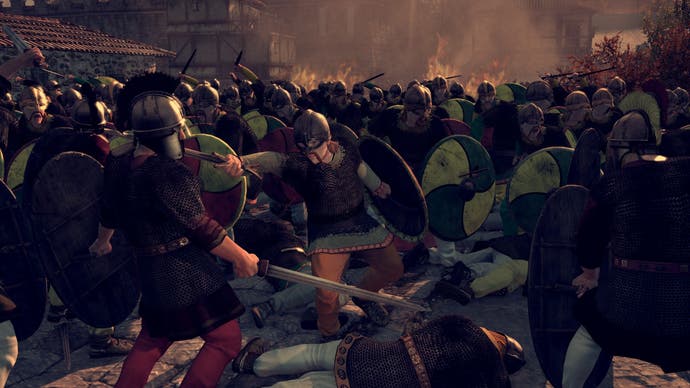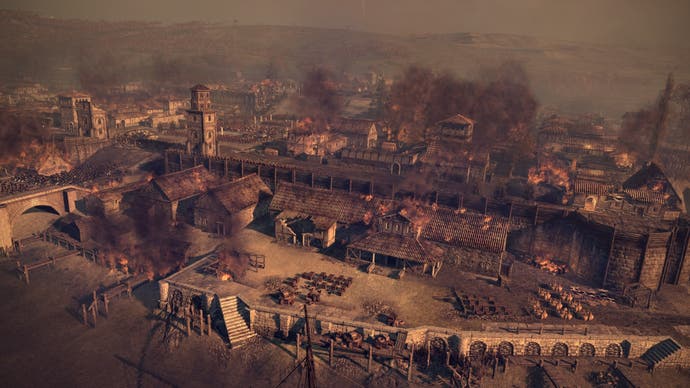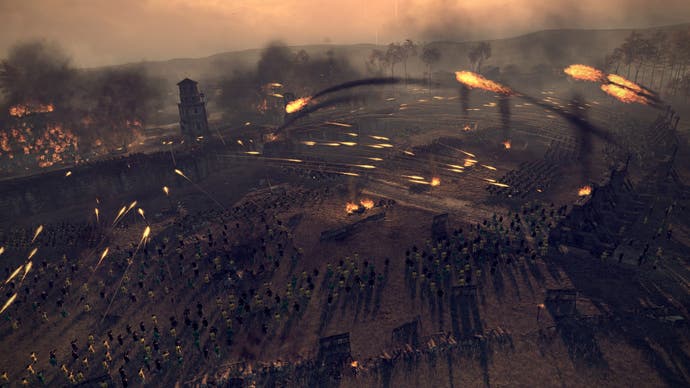Total War: Attila is your chance to save an empire - or end it
It's the end of the world as we know it.
It's the year 395 and Rome is in trouble. The great power that stretched from the Middle East to the fringes of Scotland is now collapsing. Theodosius, the last man to rule both the eastern and western halves, has died, dividing control between his sons. Their empires are not only surrounded by would-be invaders just waiting for their chance, but now even more vulnerable to the power plays of their own people. They lack the armies they needs to defend their territories and the years ahead will bring disease, famine and ruinous invasions. In time, Attila will be coming and to the newly Christianised people of Rome, he may as well be the apocalypse incarnate.
"It's a very apocalyptic game," says senior battle designer Simon Mann, describing how even the eternal city of Rome itself is at threat. "Rome is beset on all sides, even from the inside. Historically, you've got this idea of the Seven Seals being opened, you've got the four horsemen personified by Attila and his hunt. These were things that people were writing about at the time. Contemporary Christian authors were seeing disease, were seeing climate change, were seeing Attila coming down on them, and they thought 'This is it. This is the End of Days for us.' Attila was the scourge of God, the punishment for Christian sin and decadence."
It's a merry way to introduce the latest in the Total War series, but developer Creative Assembly seems rather keen on the idea of tearing everything down. Lead artist Pawel Wojs describes it as "Fitting. We've had Rome 2, with its glorious celebration of this great empire, now this is a wonderful way to close that chapter, with the dawn of the Dark Ages." The setting will likely remind fans of the Barbarian Invasion expansion for Rome: Total War, with its great hordes migrating across the map, but Creative Assembly is trying to emphasise how different Total War: Attila is to its predecessor. They're keen to frame it as both an evolution of the imperfect Total War: Rome 2, as well as a grimmer and potentially more difficult prospect.

Exactly how difficult depends, of course, on whose historical boots you shoehorn your way into. In a presentation where he swoops his view across a sickly and shrinking empire, communications manager Al Bickham says his Romans are making the best of a bad situation. "Playing as the Western Roman Empire is going to be a very challenging game," he explains. "We're designing this experience for the real Total War veterans. You've almost got to figure out what you can afford to lose." His trip north to the Roman city of York ends with him abandoning the settlement altogether, illustrating a new razing mechanic where the settlement's suffering citizens take what they can and leave almost nothing behind except, hopefully, a buffer between them and the advancing and very hungry Saxons. Saxons who, despite their rumbling stomachs, are clearly in a stronger position here.
Meanwhile, on the continent, everybody is ill, and a miasma of some sort hangs over several cities. "Diseases were a key feature of the period," Bickham continues. "We've decoupled the squalor/sanitation balance that we had in Rome 2 from public order. It's now directly related to the health of your city. If you don't keep a city clean, it may suffer disease." These diseases don't just fester, either, but spread. They can be spread during sieges, by friendly armies, by enemy armies or even along trade routes. Bickham says that city populations will decline, armies will suffer attrition and, unsurprisingly, sick soldiers fight very poorly.
I want to say that it isn't all bad news, that while there is a lot of bad news for Romans, other civilisations are on the ascendancy, but there is more bad news still to come. Creative Assembly has taken pains to model that climate change they mentioned and, as the years roll by and Europe goes through a period of cooling, harvests will suffer and people will starve.
"From the third century, the climate was changing, getting colder and colder," says lead designer Janos Gaspar. "As you begin the game, the seasons will be normal and the campaign map will be the one you know from Total War: Rome 2, but as you go further and further into the campaign, the snowline begins moving more and more to the south. In the north, there'll be multiple turns that behave like winter. It's going to change food production and economic output."

The good news is that the fall of a civilisation is going to look much prettier. Total War: Attila is plainly better looking and, after a lengthy consultation with its stylist, has also been working on its presentation. Flyby fans will enjoy more freedom with the campaign map camera, which can now zoom in much tighter or pull back to reveal much more of a continent in conflict. That continent, which is bigger than ever and now stretched as far as the Urals, is both more detailed and more distinct. Its weather, foliage and sharper textures help to make shimmering southern regions appear more arid, while northern territories are damper and dingier. The sea shines. The vegetation blooms.
The interface has also been simplified, with a new browser making it much easier to consider building options and their expansions, while technologies are presented together, rather than clicked through, to give a better perspective on possible progressions. "It's about bringing all the information front and centre," says Bickham.
New region overlays give at-a-glance reports on details such as region wealth and also religious disposition. Looking at the latter is a reminder of the great changes happening during the period and it's not simply a case of saying that particular territories hold particular beliefs. There's clearly a lot of intermingling happening. That's not going to please everybody and, as the leader of just about any faction, that's going to present you with problems, and difficult decisions, in the turns ahead.
As he clicks through the interface, Bickham also reveals something noticeably absent from Total War: Rome 2: "We've brought back the family tree, as that's a feature that it turns out fans really missed," he says. "This is our way of making characters more integral, more important to your campaign, our way of creating a greater sense of attachment to your characters and giving them more to do in the game." Once again, players can manage their friends, Romans and countrymen, increasing their standing, marrying them off or sending them away to govern distant provinces that nobody can quite pronounce. Seating governors is important, as it's the only way to enact provincial edicts.
The battle interface doesn't look quite so reworked, but those crying havoc will have an exciting new weapon at their disposal and that weapon is dynamic fire. Now, buildings can burn and fire spreads like honey on a hotplate, which sounds delightfully destructive. "At this time, a lot of buildings are made of wood," says Wojs. "If one's burning, it's probably going to spread to the other. This can happen as a result of siege weaponry, flaming arrows or even one of the new special types of unit, the raiding unit."

Such pyromania would be a shame, as more attention has been paid to the layout and composition of cities. Now, they gradually fall apart as sieges chip away at their walls, while defending generals can erect wooden barricades across streets and alleys in an attempt to create choke points or funnel attackers. As the flames rise and the invaders charge in, you might see civilians running for their lives, or maybe even have a moment to take in the many architectural styles represented in this era. While defending a demo city from enemy assault, I spotted the ruins of a classic Roman temple that my citizens had built around and even on top of. At this time in history, such a temple's founders might've been as distant from the city's inhabitants as the Jacobeans are from me.
"You've still got some of that classical style of Rome," says Mann, "but in Attila we're moving towards the Dark Ages, which includes more of this mixture of cultures that the Romans actually created themselves by conquering the lands that they did. Cultures have mashed into one big gestalt and the architecture reflects that."
However, not everyone in this time period is wholly invested in either anthropology or cultural preservation. A perfectly legitimate siege tactic is to smoke your enemies out, watching as neighbourhood after neighbourhood catches alight. Get carried away and there may not be much left afterward for you to keep, but that might've been your plan all along. Sometimes, you just have to start from scratch.
Creative Assembly won't be starting from scratch. While it's clearly a time of change in Europe, with no need for any poetic license in describing the drama all around, Total War: Attila looks more like another gentle but pleasing evolution of the series. It has a touch of paint here, a new addition there and the promise of excitement in several of its features. Series fans know the caveats by now: a larger map might mean even slower campaigns, while I had little chance to see how appropriately the sometimes quirky battle AI responded to fire. Still, this could well be another Total War game that we lose many evenings to. Perhaps even an age.

